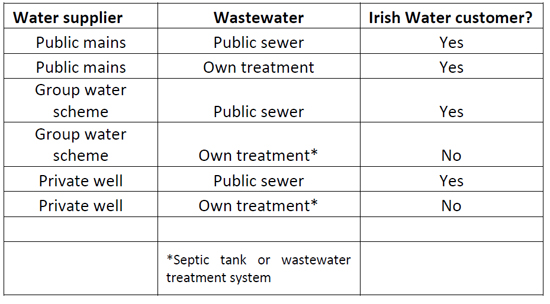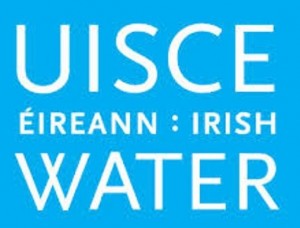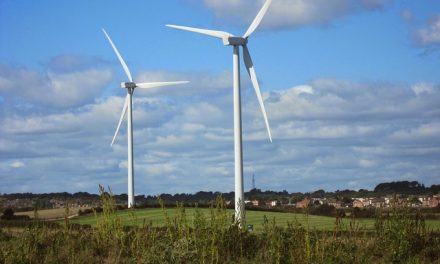On the 29th of April Enda Kenny advised that he expected to have the water charges costs available to the public before polling day, all that has transpired is that there will no standing charge and this is obviously a knee jerk reaction to the public response regarding the €100 standing charge mooted earlier in the month. Elizabeth Arnett the Head of Communication at Irish Water has advised that having no standing charge will push up the price per litre for water. This is yet another 3 card trick by the Government.
Below is the FAQ published on water.ie on the 6th May 2014, despite the promise of advising the voting public of the water charges, we still don’t know the costs involved.
3. When will the actual price for water be known? The Commission for Energy Regulation (CER) will make a final decision on the level of water charges in August, following public consultation on Irish Water’s water charges plan. It has commenced public consultation on the tariff structure and design. The CER will outline decisions in June 2014 based on the outcome of this consultation and the policy direction of the Minister.
Full FAQ
1. How much will households pay in water charges?
The Minister for the Environment, Community and Local Government has stated that the circa €537 million per annum in Government subvention of Irish Water in 2015 and 2016 will be conditional on the average water charge for households being €240 per year, subject to final assessment by the Commission for Energy Regulation.
2. How has the average figure been calculated?
This average figure has been calculated on the basis of the projected operational and capital costs of Irish water based on a high level model and various CSO data. The CER will be reviewing Irish Water costs in detail to ensure that only efficiently incurred expenditure is passed on to customers.
3. When will the actual price for water be known?
The Commission for Energy Regulation (CER) will make a final decision on the level of water charges in August, following public consultation on Irish Water’s water charges plan. It has commenced public consultation on the tariff structure and design. The CER will outline decisions in June 2014 based on the outcome of this consultation and the policy direction of the Minister.
4. How will the Irish Water bill be structured?
For households fitted with an Irish Water meter when charging commences, charges will be based on usage above a free allowance. Each household will receive a free allowance of 30,000 litres of water (and a corresponding amount of waste water treated) a year. To put this in context: the average household (2.7 people) uses about 140,000 litres of water per year in relation to its primary residence.
In addition, households will receive from Irish Water a free allowance to cover a child’s normal consumption of water supplied and waste water treated so that charges only apply to adults in households. The allowance per child will be up to 38,000 litres per annum – the level of consumption underpinning this allowance to be verified from actual metering data); charges will be based on usage above the free allowance. The Commission for Energy Regulation (CER) will, following public consultation, determine the water tariff as part of Irish Water’s water charges plan – the CER has indicated that this will be finalised in August.
Households connected to the public systems but without an Irish Water meter will be charged on an assessed basis, using a good proxy for usage. The CER will, following public consultation, determine the assessed water tariff as part of Irish Water’s water charges plan, which will be finalised in August.
In addition, the Minister will be issuing the CER with a direction, using his statutory powers, to provide that:
o the fixing of domestic charges for 2015 and 2016;
o there will be no standing charge for domestic customers for social and environmental reasons (a minimum charge may be applied to properties that are not permanently occupied e.g. holiday homes);
o assessed charges will be based primarily on occupancy and possibly refined based on data from metered usage to ensure that they are as close a proxy for metered usage as possible;
o the CER to ensure provision is made for retrospective adjustment of charges including a rebate (above a reasonable threshold) in the context of transitional arrangements for people from moving from assessed to metered home;
o charges to be capped for people with high water usage due to certain medical conditions; and
o Irish Water to take account of the quality of services provided to customers, including circumstances where services are reduced or restricted (e.g. due to boil water notices).
5. When will households receive their first bills and how will bills be structured?
Water charges will commence on 1 October 2014, but households can expect to receive their first bills in Quarter 1 2015, with bills issued in arrears, similar to domestic electricity and gas bills.
6. What is the level of free allowance?
Each household will receive a free allowance of 30,000 litres of supplied water (and a corresponding amount of waste water) a year per primary residence. In addition, households will receive an additional free allowance for every child under 18 (aligned with entitlement to child benefit) to cover a child’s normal consumption of water supplied and waste water treated (this will be up to 38,000litres per annum – the level of consumption underpinning this allowance to be verified from actual metering data); effectively, water charges will only apply to adults.
This means for a family of 2 adults and 2 young children, using about 190,000 litres of water, the free allowance will be 106,000 litres – more than 50% of their usage.
7. What other affordability measures are being provided apart from the free allowance?
People with high water usage for certain medical conditions will have their bills capped at the relevant assessed charge. There will be a lower water tariff for single occupant households as part of the assessed mechanism. The absence of a standing charge for domestic customers will benefit smaller households, who can then manage their usage, and the free allowance for children will benefit families.
Irish Water’s water charges plan will have to take account of the quality of services provided to customers, including circumstances where services are reduced or restricted (e.g. due to boil water notices).
8. What medical conditions will qualify people for the capping of water bills?
The Minister for the Environment, Community and Local Government will issue a direction to the CER, following consultation with the Minister for Health, the HSE and Irish Water on qualifying conditions, which will for example include people using home kidney dialysis.
9. What informed the Government’s approach towards the free allowance, affordability supports and its other decisions?
The Government has sought, through its decisions on the free allowance, to protect larger families and households with single occupants, groups identified through work by an inter-Departmental group (IDG) on affordability measures issues as being potentially vulnerable. These groups and people with high water usage due to medical conditions were also identified by the community and voluntary pillar of social partnership, which engaged with the IDG. The IDG will continue to work to oversee the practical administrative arrangements for the free allowance.
10. Who is responsible for paying domestic water charges?
The occupier of a premises is liable for paying domestic water charges. Under the Water Services (No.2) Act 2013, it is presumed that the owner of a premises is the occupier unless proved otherwise. Where a customer fails to pay a charge, it shall be recoverable by Irish Water as a simple contract debt in any court of competent jurisdiction.
11. What happens if people do not pay their bills?
Irish Water will have measures in place to allow for ease of payment of Bills. In the case of failure to pay, Irish Water is empowered to reduce water pressure in order to restrict supply. Water disconnection due to non-payment of domestic water charges is prohibited. If a customer fails to pay a water charge, it shall be recoverable by Irish Water as a contract debt in any court of competent jurisdiction.
Irish Water will be required to ensure in the water charges plan submitted to the CER that free allowances are only applied to households who pay their charges in a timely manner i.e. where charges are paid in accordance with the approved water charges plan or an approved agreement.
12. Who will be a customer of Irish Water?
13. What households will receive a free allowance?
Primary residences will receive a free household allowance. Free allowances for children will also apply to primary residences. Non-principal private residences (such as holiday homes) will not receive a free household allowance.
14. Will there be provision for customers to apportion a free allowance between more than one residence?
No. The free allowance is for a person’s primary residence.
15. Will there be different payment options for Irish Water?
Irish Water will announce details of payment options in due course, as agreed with the CER, which has powers of direction over Irish Water to produce codes of practice relating to performance standards, customer billing, payment methods, Irish Water communication to customers and customer complaints. It is expected that, similar to payment systems for the other utility services, there will be a range of flexible payment options available for customers of Irish Water.
Irish Water has signalled its intention to introduce a range of payment options for customers, including an easy payment option for customers who wish to make regular payments of not less than €10 per transaction.
16. What will happen to households on a group water scheme?
The current subvention of group water schemes will be adjusted to align subvention with the free allowance approach towards households on public water supplies to ensure households in this sector receive equivalent support, while allowing for any transitional issues, to sustain improvements in quality in the group water sector. The Department of the Environment, Community and Local Government will consult with the National Federation of Group Water Schemes on arrangements for the group water sector.
17. What decisions has the Government made today?
Each household will receive a free allowance of 30,000 litres of water supply (and a corresponding allowance for wastewater) per annum (for primary residences only).
Each household will receive an additional allocation for every child under 18 (with entitlement aligned with child benefit) to cover the normal water consumption of a child.
The Minister for the Environment, Community and Local Government will use his powers to issue a policy direction to the CER:
o the domestic charging regime will be fixed for 2015 and 2016;
o for social and environmental reasons, there will be no standing charge for domestic customers (a minimum charge may be applied to properties that are not permanently occupied e.g. holiday homes);
o Assessed charges will be based primarily on occupancy and possibly refined based on data from metered usage to ensure that they are as close a proxy for metered usage as possible;
o the CER to ensure provision is made for retrospective adjustment of charges including a rebate (above a reasonable threshold) in the context of transitional arrangements for people from moving from assessed to metered home;
o Charges to be capped for people with high water usage due to certain medical conditions; and
o Irish Water to take account of the quality of services provided to customers, including circumstances where services are reduced or restricted (e.g. due to boil water notices).
Irish Water will receive an operational subvention averaging in excess of €530m in 2015 and 2016, and provision is being made to provide equity of just over €400m in equity to Irish Water in 2015 and 2016 (this is in addition to a capital provision of €240m by way of equity in 2014). This will bring the overall capital programme in 2015 and 2016 to over €400m – €100m higher than current levels.
Irish Water will deliver a free first fix scheme, entitling every household to a free fix of the first leak identified on a customer’s water supply pipe.
The Government will adjust the subsidy to group water schemes to ensure that households in that sector receive equitable support by comparison with households on public water supplies.
18. What are the details of the free first fix scheme?
Irish Water will deliver a free first fix scheme, entitling every household to a free fix of the first leak on a customer’s water supply pipe, between the property boundary to within one metre of a property. The scheme is estimated to cost some €51 million to the end of 2016. Details will be announced by Irish Water in due course.
19. When will the free first fix scheme commence?
The commencement date and other details of the scheme will be announced by Irish Water shortly.
20. Will households that have already been metered be able to avail of the free first fix scheme?
Yes. The commencement date and other details of the scheme will be announced by Irish Water shortly.
21. What is the timeline for remaining decisions regarding water charges?
During 2014, the CER is expected to publicly consult and make decisions on a number of issues, including:
22. What level will the standing charge be – will it be 33% as suggested by Irish Water?
There will be no standing charge for domestic customers but a minimum charge may be applied to properties that are not permanently occupied e.g. holiday homes.
23. If there is no standing charge, will people have to pay water charges on second homes?
While water charges will be based on usage with no free allowance in a second home – where they are not permanently occupied a minimum charge may be applied. This will be considered by the CER. Therefore, any water usage in non-primary residences will be charged.
24. Will Irish Water’s domestic customers in mixed use premises (i.e. a property with a business and a household) have the same free allowance as domestic customers in households?
The CER will make a determination on this following public consultation on the non-domestic tariff structure. However, the Minister envisages that any decision by the CER will be guided by the principle of equity for all customers with a domestic supply.
25. Will there be rebates?
The CER has commenced public consultation on the proposed structure of tariffs and this includes consideration of transitional arrangements for people moving from assessed to metered charges. The Minister has indicated his intention that CER should in this context ensure provision for retrospective adjustment of charges including a rebate (above a reasonable threshold).
26. How might a rebate system work?
The Minister intends issuing a direction to the CER requiring it to ensure provision for retrospective adjustment of charges, i.e. a household’s charges will be adjusted if assessed bills are higher, and above a certain threshold, than metered usage shows they should have been.
27. What is the annual cost of water services?
The annual cost of water services is over €1 billion per annum. The Government’s decisions on subvention and allowance were based on the level of funding required by Irish Water during 2015 and 2016 and an average level of domestic water charges that will contribute to the funding of water services.
28. What happens after 2016?
It is anticipated that Government subvention to Irish Water will continue beyond 2016. Decisions on water charges beyond 2016 will be decided in advance of the next Irish Water revenue control period, 2016-2022.
The level of charges beyond 2016 will reflect the Government’s policy in relation to free allowances and the utility’s changing financial model as well as the need for extra investment to tackle the current infrastructural deficit. The fact that Irish Water is a commercial semi-state body, with borrowing not included on the general government balance, provides alternatives for more sustainable funding for the sector.
29. What happens next?
The CER has commenced public consultation on the proposed structure of tariffs. The Minister will publish the proposed direction to the CER in draft form, and so there will be ample opportunity for engagement on these issues in advance of the final setting of the charges by the CER in August 2014.
Consultation by the CER in late June will provide information on the financial costs of Irish Water and the proposed level and structure of charges.
Irish Water will deal with all the practical arrangements flowing from the CER consideration and Government decisions, including direct engagement with customers on qualifying for the free allowance as the process develops.
30. What are the Regulator’s powers in water regulation?
The CER is the independent economic regulator of Irish Water. The CER retains the power to advise the Minister on development and delivery of water services. It will:
set performance standards for the new utility;
examine Irish Water’s operational costs and capital plans and approve water charges plans in the light of these costs; and
have powers of direction over Irish Water to produce codes of practice relating to performance standards, customer billing, payment methods, Irish Water information communication to customers, and customer complaints.
The Minister for the Environment may give the CER a direction of a general policy nature, which the CER must comply with. Such directions will only be given with adequate reasoning, consultation and advanced notice.
Public consultation will form part of CER’s decision-making processes. It has already held a public consultation on a proposed economic regulatory framework, which will inform the CER’s advice to the Minister for the Environment, Community and Local Government on economic regulation. It is currently holding public consultations on the structure of the domestic and non-domestic tariffs, and on customer protection measures.
31. Why do we need to pay for water?
Water and wastewater services are expensive and require increased infrastructural investment after years of underinvestment. The current funding situation, with only approximately 15% of costs borne directly by users, is unsustainable.
The public water system requires urgent and increased investment. 23,500 people are on boil water notices. 40% of our water supply is lost on leakage. 16% of our water supplies are at risk, affecting over 1 million people. One-third of secondary waste water treatment plants had inadequate effluent standards in 2012. There is virtually no spare supply capacity in Dublin. With increased investment, these issues can be addressed.
In order to secure extra investment in water services (to improve water quality, tackle pollution and address leakage), the Government is applying the user pays principle to water services. Those who use water will pay for it directly.
32. How do I find out if I will be metered by the time water charges commence?
Households can contact Irish Water’s customer contact centre (Ph: 1890 278 278), which will provide an indicative timetable for when meters will be installed in a certain area.
33. How can I proactively monitor my water usage when the meter is underground?
People can identify leakage by performing a meter reading before and after a period when the house is unoccupied and no appliance requiring water is in use. This can be done by lifting the lid of the meter, noting the reading, and checking it again after returning.
In addition people can regularly check their water meter readings so see how many cubic metres (1 cubic meter equals 1,000 litres) have been used. The average water usage per person in Ireland is estimated at 145 litres per day).

















